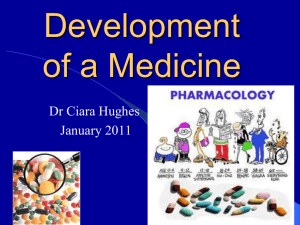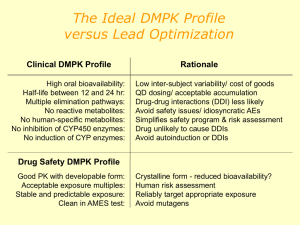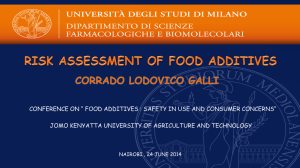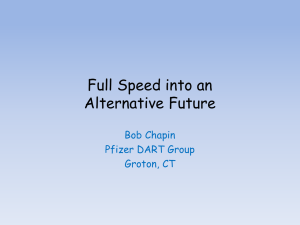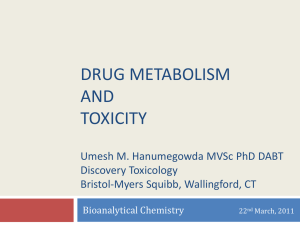Toxicity Testing in the 21st Century
advertisement
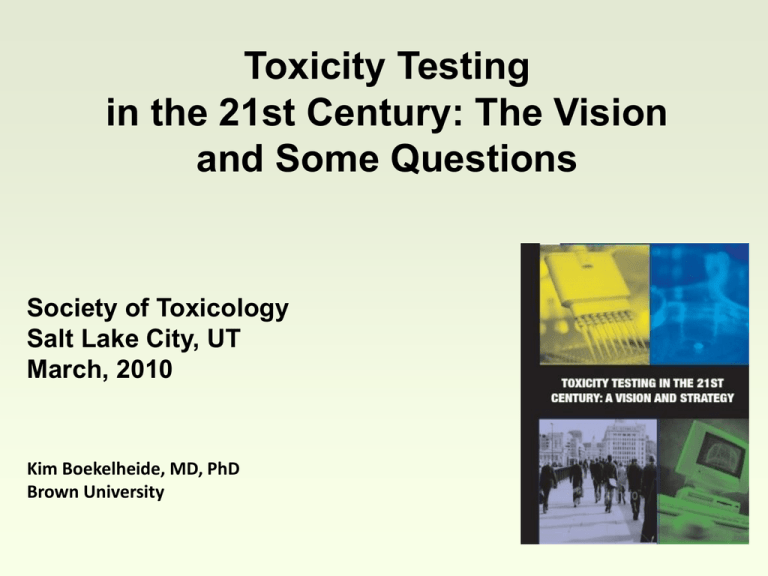
Toxicity Testing in the 21st Century: The Vision and Some Questions Society of Toxicology Salt Lake City, UT March, 2010 Kim Boekelheide, MD, PhD Brown University Increasing frustration with current approaches to toxicity testing from many sectors… Low throughput; expensive Questionable relevance to actual human risks Conservative extrapolation defaults Traditional approaches dating to 1930’s Little use of modern biology, mode of action Reliance on animals Question: What are the limitations/advantages of the current testing approach that relies on animals? Vision of a future of toxicity testing based on a very different paradigm…… Multiple doses in vitro Defined number of toxicity pathways High throughput Expensive to develop, cheap to do Fast Mechanistic endpoints In vitro-to-in vivo extrapolations of dose response Based on human biology Question: What are the limitations/advantages of the proposed new testing paradigm? A National Research Council Committee Sponsored by the US EPA with support from NIEHS Advance the practice of toxicity testing and human health assessment of environmental agents Committee Roster Daniel Krewski (Chair), University of Ottawa, Ottawa, ON Daniel Acosta, Jr., University of Cincinnati, Cincinnati, OH Melvin Andersen, CIIT Centers for Health Research, Research Triangle Park, NC Henry Anderson, Wisconsin Division of Public Health, Madison, WI John Bailar III, University of Chicago, Chicago, IL Kim Boekelheide, Brown University, Providence, RI Robert Brent, Thomas Jefferson University, Wilmington, DE Gail Charnley, HealthRisk Strategies, Washington, DC Vivian Cheung, University of Pennsylvania, Philadelphia, PA Sidney Green, Howard University, Washington, DC Karl Kelsey, Harvard University, Boston, MA Nancy Kerkvliet, Oregon State University, Corvallis, OR Abby Li, Exponent, Inc., San Francisco, CA Lawrence McCray, Massachusetts Institute of Technology, Cambridge MA Otto Meyer, Danish Institute for Food and Veterinary Research, Søborg, Denmark D. Reid Patterson, Reid Patterson Consulting, Inc., Grayslake, IL William Pennie, Pfizer, Inc., Groton, CT Robert Scala, Exxon Biomedical Sciences (Ret.), Tucson, AZ Gina Solomon, Natural Resources Defense Council, San Francisco, CA Martin Stephens, The Humane Society of the United States, Washington, DC James Yager, Jr., Johns Hopkins University, Baltimore, MD Lauren Zeise, California Environmental Protection Agency, Oakland, CA With particular thanks to Mel Andersen for permission to use his slides A transformative redefinition of toxicity testing is required to meet key design criteria. Design Criteria: Toxicity Testing of Environmental Agents Broadest coverage of chemicals, end points, life stages Fewest animals; least suffering for those used Lowest cost; least time Detailed mode of action and dose response information for human health risk assessment Contents 1. 2. 3. 4. 5. 6. Introduction Vision Components of Vision Tools and Technologies Developing the Science Base and Assays to Implement the Vision Prerequisites for Implementing the Vision in Regulatory Contexts Options for Future Toxicity Testing Strategies Table 2-1 Option I In Vivo Option II Tiered In Vivo Option III In Vitro/In Vivo Option IV In vitro Animal biology Animal biology Primarily human biology Primarily human biology High doses High doses Broad range of doses Broad range of doses Low throughput Improved throughput High and medium throughput High throughput Expensive Less expensive Less expensive Less expensive Time consuming Less time consuming Less time consuming Less time consuming Relative large number of animals Fewer animals Substantially fewer animals Virtually no animals Apical endpoints Apical endpoints Perturbations of toxicity pathways Perturbations of toxicity pathways Some in silico and in vitro screens In silico screens possible In silico screens Components of the Vision Toxicity Testing … a not-so-distant future where all routine toxicity testing will be conducted in human cells or cell lines in vitro by evaluating perturbations of cellular responses in a suite of toxicity pathway assays. Andersen and Krewski (2009). Toxicity Testing in the 21st Century: Bringing the Vision to Life. Tox. Sci., 107, 324-330. Question: How long will it take to implement this new toxicity testing paradigm? Toxicity Pathways A cellular response pathway that, when sufficiently perturbed, is expected to result in an adverse health effect. Just a normal biological signaling pathway and its components Question: Is the focus on “toxicity pathways” useful or distracting? What are the toxicity pathways? How many are there? Endogenous hormones DNA damage PXR, CAR, PPAR and AhR receptors Nrf2 oxidative stress Hypo-osmolarity Heat-shock proteins p38 MAPK Designing Toxicity Pathway Assays Possible approach In vitro, rapidly performed toxicity pathway tests in primary human cells, cell lines, or tissue aggregates Isolate cells from patient with genetic disease Rapid progress since completing the report: Human stem cell biology Better access to human cells Bioengineered tissues Question: Does a test for neurodevelopmental effects have to look at neurons? Transfect and generate pluripotent stem cells Generate differentiated tissues with known genetic defect Targeted Testing – toxicogenomics, etc. Assess pathways, integrate tissue responses, and in some cases evaluate metabolites Discuss use of new technologies in targeted testing strategies In the new approach, Toxicity pathways assays, better reflecting biological targets and modes of action Increased speed and throughput for chemicals and decreased costs and animal usage Move away from extrapolating from high dose animal results to low doses in humans and focus on results of perturbations of toxicity pathways in humans Now extrapolations include in vitro - in vivo and across levels of biological organization Dose-Response and Perturbation of Toxicity Pathways Exposure Tissue Dose Biologic Interaction Low Dose Higher Dose Higher yet Perturbation Normal Biologic Function Biologic Inputs Early Cellular Changes Adaptive Stress Responses Question: How do we distinguish adaptive versus adverse (toxic) responses? Cell Injury Morbidity and Mortality Dose Response and in vitro to in vivo extrapolations Dose response modeling of perturbations of pathway function would be organized around computational systems biology models of the circuitry underlying each toxicity pathway. In vitro to in vivo extrapolations would rely on pharmacokinetic models – ideally physiologically based pharmacokinetic models that would predict human blood and tissue concentrations under specific exposure conditions. Andersen and Krewski (2009). Toxicity Testing in the 21st Century: Bringing the Vision to Life. Tox. Sci., 107, 324-330. Systems Modeling of Toxicity Pathways Computational systems biology description of pathway circuitry to support dose response modeling of pathway perturbations Virtually all biology is controlled by non-linear feedback (positive and negative) k1 mno k3 mno xyz abc k2 k8 xyz k9 k5 k4 k6 qrs fgh k7 qrs abc fgh Map and model circuitry of the toxicity pathway assay for dose response assessment and to assess susceptibility factors Dose Response Models Linking Perturbations to more Integrated Responses Computational systems biology description of pathway circuitry for creating biologically realistic dose response models Dose dependent transition studies for sequential pathway activation to understand linkage to cell and tissue level responses (perturbations to adaptation to adversity) How does the new ‘risk’ paradigm compare to the 1983 Red Book for environmental agents? Chemical Characterization Dose Response Assessment “Mode of Action” Compounds Affected Pathway Assess Biological Perturbation Metabolite(s) Population Based Studies Dose Response Analysis for Perturbations of Toxicity Pathways Calibrating in vitro and human Dosimetry Measures of dose in vitro Human Exposure Data Hazard Identification Risk Characterization Exposure Assessment Exposure Guideline Some advantages Toxicity testing more focused on human biology; not an uncertain reflection of high dose animal studies for what is expected at low doses in humans Creates detailed understanding of pathway targets, functional design of pathway circuitry , more diverse dose response models for target and integrated cellular responses for ties to possible outcomes And promises Human relevance Dose relevance Chemical coverage Mixtures effects on toxicity pathways Mechanistic focus: mode of action based Cost effective Fast The 3 Rs: replacement, reduction, refinement Challenges……. Assay Design/Development for Toxicity Pathways Improved methods to identify (predict) and test metabolites – targeted testing Co-ordinate development of ‘functional genomic tools’ to map and model pathways and use results to establish safe levels of exposures Train toxicologists and regulators about need for new approach and then in the tools and methods that will be involved in the transformation And conundrums……. Question: Is this a screening tool or a standalone system? Question: How is the new paradigm validated? Question: What about epigenetics and other new biology?
